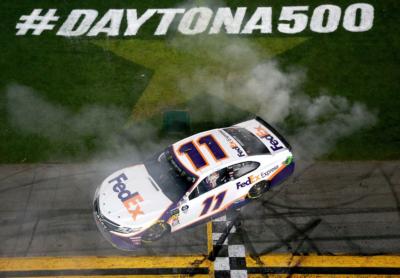Sure, people complained about the type of racing NASCAR drivers delivered through most of Speedweeks. The single-file, follow-the-leader parades that were the Advanced Auto Parts Clash, the Gander RV Duels, and the Xfinity Series race were boring and even some drivers didn't understand why more of their brethren weren't taking chances passing on the low line. And then there was the bloodbath of a Gander Outdoors Truck Series race that saw only nine of 32 entries finish. And a litany of late-race wrecks made the last ten laps last an hour in Sunday's Daytona 500. But the Great American Race delivered a show on levels many weren't expecting.
First, most of Sunday's 207 laps (remember that seven were run in NASCAR Overtime) saw the pack staying two-wide and many rows deep. Passing the leader was still difficult, as the two lead cars could usually push themselves away from the pack enough to keep the challenging rows at bay. But, save a large portion of the 60-lap Stage 2, this Daytona 500 displayed the kind of racing many expect at this track and Talladega. Pit strategy, handling, and executing the precise moves also came into play, meaning the race would not crown some random winner.
The Daytona 500 belched more storylines than a clogged interstate does smog on a summer day. First, Denny Hamlin's second triumph in the sport's biggest race helps silence the whispers about his future in the No. 11 FedEx Joe Gibbs Racing Toyota, after a winless 2018 campaign. Hamlin ran near the front most of the day and did so with Chris Gabehart in his first race as the No. 11 team crew chief. Hamlin won
The Joe Gibbs Racing angle may be the biggest story of the weekend and is certainly the most sentimental. Gibbs' son, J.D., passed away at age 49 in January. J.D. ran the team for over two
Speaking of, racing virtuoso Kyle Busch finished 2nd and was leading for much of the
The race's giant wrecks eliminated many entries, leaving only 19 running at the finish and 14 on the lead lap. But damaged cars still got good finishes. Erik Jones (3rd) drove up from 7th in the last two laps and came back from being a lap down and having heavy
And, as is often the case in plate races, underdogs shined. Matt DiBenedetto's first race in the JGR-affiliated No. 95 Leavine Family Racing Toyota saw him lead the most laps in the race, but get turned by Paul Menard with ten laps to go, triggering the 22-car melee that eliminated both them and many others. Michael McDowell finished 5th, driving from the back to the front after a pit penalty. Rookie Ryan Preece must play darts or
Conflict arose post-race, as Joey Logano (4th) confronted McDowell verbally for making the wrong move and costing both Ford drivers the win. McDowell told the media
Saturday's Xfinity Series race crowned a first-time winner in journeyman veteran Michael Annett. After a couple of years of struggling in good equipment, team owner Dale Earnhardt Jr. said that he and others had to get Annett into a more confident mind state. Annett had driven for years in backmarker cars and was arriving at races just absolutely thinking he couldn't win. Annett said that he saw the trophy in the driver's meeting and thought he absolutely could win this race. And the win was redemptive for crew chief Travis Mack, who left the Hendrick Motorsports umbrella in 2018 to partner with Kasey Kahne at the No. 95
Friday's
The crowds were large all weekend. The Daytona 500's grandstands sold out for the fifth-straight
Finally, owners, drivers, manufacturers, and NASCAR executives have made clear that a new era in the 71-year-old sport is on the horizon. A new schedule with possibly shorter races,
The 2019 Daytona 500 was the beginning of a new season, but it also could be the beginning of the end of an era of sorts. Tapered spacers replace restrictor plates at Talladega in May, though the racing on these tracks will stay similar. The real racing season begins in just a few short days and how the aero package plays out will be pivotal in how the aforementioned steps advance. But the buzz leaving Daytona International Speedway is as good, if not better than it has been in years. Momentum is important in racing - both on the track and off of it.

